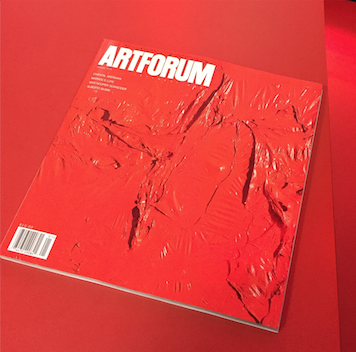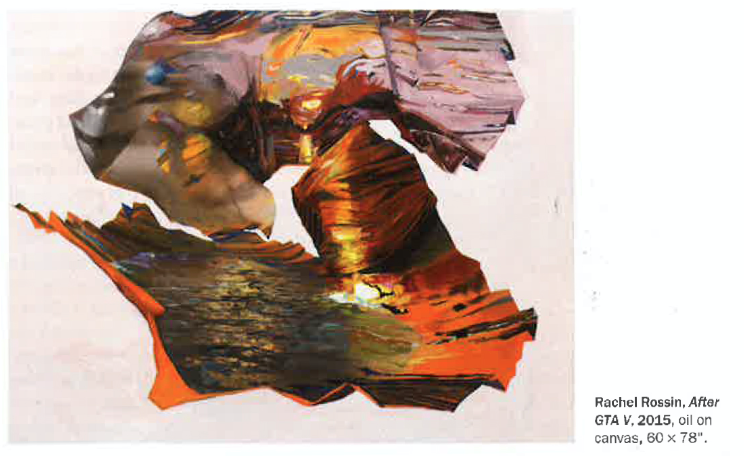 Rachel Rossin | ZIEHER SMITH & HORTON | JANUARY 2016
Rachel Rossin | ZIEHER SMITH & HORTON | JANUARY 2016 Themes from Lewis Carroll's Through the Looking Glass loom large throughout William Gibson's 2003 novel Pattern Recognition, which characterizes an American protagonist's trip to the UK as a disorienting encounter with a "mirror-world." But while Carroll framed his chiral universe as the product of minds and dreams, Gibson found alterity in machines and devices. Both these modes seemed alive in "Lossy," Rachel Rossin's recent solo show, whose nine paintings and a piece experienced via an Oculus Rift virtual-reality headset—titled 1 Came and Went as a Ghost Hand, 2015—bore unmistakeable traces of Carroll's dark yet innocent whimsy as well as Gibson's tech-saturated neurasthenia.
Exhibiting an Oculus Rift work is a risky business. It's apt to monopolize the attention of novelty seekers while causing skeptics—those who can't forgive the burgeoning medium for its rough edges and unresolved questions—to shuffle quickly on by. (One such unresolved question: Should an Oculus Rift headset be exhibited on a pedestal?) In "Lossy," these risks yielded rewards when the device's limitations became a foil to painting's by-now-familiar constraints. There's nothing that quite emphasizes the static materiality of paint like a virtual world that offers zero physical resistance as viewers move specter-like through fragmented forms. In I Came and Went as a Ghost Hand, that virtual world lay somewhere between The Cabinet of Dr. Caligari and The Martha Stewart Show: Its two-and-a-half-minute looped mix of landscape and domestic space included canned goods in a fridge door overhead, a multicolored bed seemingly underfoot, and walls and vases and shrubbery drifting in place with the languor of inner tubes on a pool.
Overall, Rossin's process is a sort of exquisite corpse played out between human and machine: To create her canvases, she scanned various kinds of images and digitally manipulated them, then painted the results as observed from a computer screen. These image deforma-tions were more than just your garden-variety Photoshop play: For the piece After GTA V, 2015, the artist began with the image of a sunset from Grand Theft Auto V (2013), and then crumpled and wadded it up, a bit like Richard Tuttle might crumple a canvas—the difference being that Rossin did so in simulated 3-D space, using photogrammetry software (which assigns and records distances between various coor-dinates of an image), and then translated the on-screen results back into an oil on canvas.
A similar process led to the genesis of Mirror Milk, 2015, which at first seems to depict a roughly painted kitten through a filter of soft tropicalia. The feline visage within, as it turns out, is a scanned image of a drawing Rossin made as a child. (According to Rossin, the work's title nods to Carroll's Alice asking her pet cat about "looking-glass milk"; to some Gibson fans, the title also inevitably evokes the "mirror-world milk" described in Pattern Recognition.) Meanwhile, the seed

image of Self Portrait, 2015, was just that—an image of the artist, around which she digitally wrapped a scanned j PEG of a painting from her previous show. After subjecting the already warped images to a software simulation of gravitational forces, she then rendered the out-come as a painting; the result looks like a melting rainbow-sherbet bust of Baphomet.
The abstract imagery in Rossin's compositions seemingly comes from two places: from her own expressionist intuition and from rule-based, algorithm-driven filters of her image-editing software. (If the former inherits something of Carroll's world, produced via the uncon-scious, the latter inhabits the spirit of Gibson's, constituted via technol-ogy.) The show's fireworks happened at the intersection of these two modes, where the optical gobbledygook generated by a computer was rendered by hand as oils on canvas, and framed in the evolving tradition of abstract painting. In "Lossy," there was most cenainly a kid hacker flexing her muscles. But the show revealed another image of Rossin as well: a painter who, for the moment, has found a very good vantage point from which to survey the chaos of a shifting media landscape. —Dawn Chan Rachel Rossin, After GTA V. 2015, oil on canvas, 60 x 78".